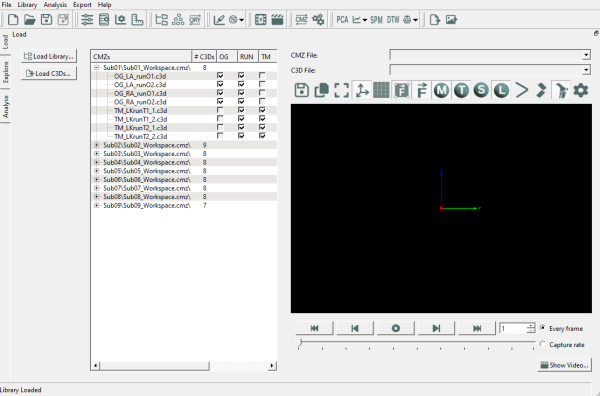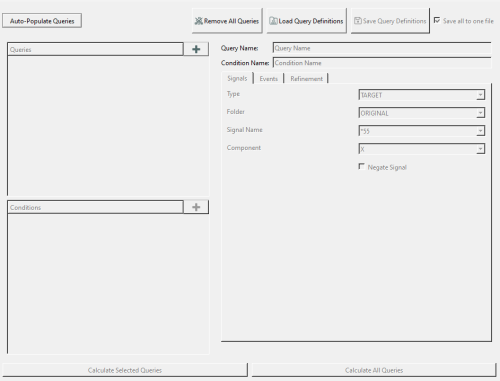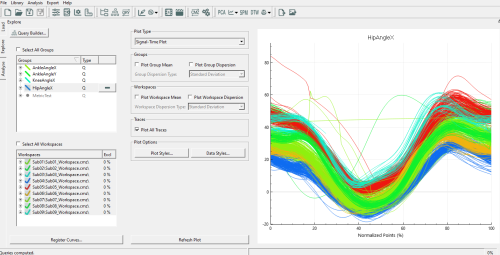Sift Tutorial - Load and View Data: Difference between revisions
| Line 76: | Line 76: | ||
<li>Select a particular group in the <strong>Groups</strong> of the explore page to determine what signals you would like to view</li> | <li>Select a particular group in the <strong>Groups</strong> of the explore page to determine what signals you would like to view</li> | ||
<li>Selecting different explore pages' <strong>Workspaces</strong> widget determines which are displayed. Checking the <strong>Select All Workspaces</strong> box conveniently displays all of the workspaces associated with the selected group(s)</li> | <li>Selecting different explore pages' <strong>Workspaces</strong> widget determines which are displayed. Checking the <strong>Select All Workspaces</strong> box conveniently displays all of the workspaces associated with the selected group(s)</li> | ||
<li> | <li>Set the plot type to Signal-Time and check the appropriate boxes to plot all sequences, workspace means/standard deviations, and group means/standard deviations</li> | ||
<li>Click <strong>Refresh Plot</strong> | <li>Click <strong>Refresh Plot</strong> | ||
</ol> | </ol> | ||
Revision as of 13:48, 27 March 2024
| Language: | English • français • italiano • português • español |
|---|
This tutorial begins by assuming that you have a CMZ file for each subject.session from Visual3D. If necessary you can use our build CMZ feature or work through the Visual3D tutorial for building a CMZ file.
Data
This tutorial can be completed with any CMZ file. One possibility is a data set from a Visual3D Workshop at a recent ASB meeting: V3D Workshop @ ASB.
Load Library

To start, you need to tell Sift where to look for you data. After opening Sift:
- Click the
 Load Library on the toolbar or the top left of the load page:
Load Library on the toolbar or the top left of the load page:
- Click Load
- One the library is loaded, you will be able to do initial exploration on the Load page:
- Verify which CMZ file have been loaded in the 3D Viewer, as well as which C3D files are associated with each CMZ;
- Verify which file tags are present in the library;
- If you have loaded multisubject data, verify which subject prefixes and subject tags are present in the library; and
- Animate the data contained in any loaded C3D file.
Define queries and group signals

Once you have loaded the library, navigate to the explore page, where you can automatically or manually define queries that will group the signals in your library. To do this:
- Click on the
 Query Builder Dialog... button.
Query Builder Dialog... button. - Either manually create group definitions by
- OR click Auto-Populate Queries
- Once you have created your query definitions: Click Calculate All Queries to apply the queries you have defined to the loaded library.
- Close the Query Builder dialog. Note that if Sift has not finished computing all of the groups then it will ask you if you want to continue. Click Compute Groups.
Visualize your data

Now that the signals in the library have been grouped, it is now possible to visually examine them and begin exploring your data in the explore page:
- Select a particular group in the Groups of the explore page to determine what signals you would like to view
- Selecting different explore pages' Workspaces widget determines which are displayed. Checking the Select All Workspaces box conveniently displays all of the workspaces associated with the selected group(s)
- Set the plot type to Signal-Time and check the appropriate boxes to plot all sequences, workspace means/standard deviations, and group means/standard deviations
- Click Refresh Plot
Interact with your data
You can highlight a trace by left-clicking on it. This causes the trace to become more visually prominent than non-highlighted traces and produces a tooltip that includes:
- The trace's group name
- The trace's workspace name
- The name of the specific C3D file for that trace
- The trace's frame range from that C3D file
- The trace's sub-group name
- The x- and y- values of the trace where you left-clicked it
A trace can be excluded from the plot by:
- left-clicking on the trace to highlight it; then
- right-clicking and selecting Exclude -> Exclude Trace(raw data) from the context menu.
You can confirm that the trace has been excluded in the Workspaces widget: excluded traces will be marked with a red X and workspaces containing excluded traces will have their check-mark icon replaced with an X.
Save the application workspace
Click ![]() Save Workspace As to save the work you've done so far. This saves the application workspace as and .i3d file, which is an XML file.
Save Workspace As to save the work you've done so far. This saves the application workspace as and .i3d file, which is an XML file.
NOTE: if you have excluded data then you CMZ files are out of sync with you Sift workspace at this point. This eans that if you re-queried the loaded library, you would need to exclude that traces again. To avoid this, click the ![]() Update CMZ files icon on the toolbar to update you CMZ files at any point.
Update CMZ files icon on the toolbar to update you CMZ files at any point.